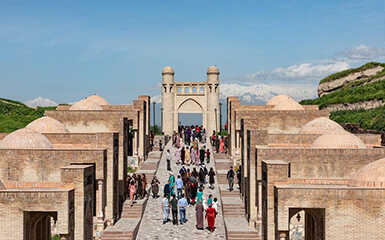Kok Gumbaz
Ajina Teppa
Ancient Panjakent
Anzob Tunnel
Beshkent Qala
Childukhtaron
Khazrati Shokh
Mug Teppa
Gharm Chashma
Hisor Historical
Haji Yaqub mosque
Hazrati-Bobo complex
Lake Iskanderkul
Kalai-Khumb
Karatag
Karon
Khishtin caravanserai
Khorog
Khulbuk
Lake Karakul
Abdullatif Sultan
Madrasai Kuhna
Abu Abdullah Rudaki
Khoja Mashhad
Khudoyor Valami
Makhmudi Azam
Mir Sayyid Ali Hamadani
Muhammed Bashoro
Sheikh Muslihiddin
Nurek Mountain Lake
Pamir
Sarazm
Sari-Khosor
Seven Lakes
Shirkent
Chiluchorchashma
Takht-i Sangin
Khishtin caravanserai

Caravanserais is an indispensable feature of all Eastern cities where trade routes pass. Hissar valley was no exception in this case, and combined East Turkestan with the ancient Merv and Termez cultural centres. Therefore, the construction of the caravanserai was in the first place and was in great demand on all routes.
Medieval Hissar was one of the trade hubs in Central Asia. It was crossed by numerous trade routes with waving seas of caravans passing by. Weary travellers arriving in Hissar stayed in the famous Khishtin caravanserai.
The caravanserai Khishtin is one of the surviving monuments of the historical and cultural complex of Hissar. This medieval guesthouse was built in 1808 next to the Kuhna madrasah. "Khishtin" is translated as "made of brick", since the fragments of the existing foundation of the building and the ruins of the walls were laid entirely of burnt brick. This is rather unusual, as burnt brick was more commonly used in the construction of rulers' palaces, madrassas and mosques.
The building of the caravanserai is not completely preserved. Its original state was recorded in 1913 in the only photo on the basis of which the architecture-renovators restore the monuments. Fragments of walls with a height of no more than one meter are left only of the original building. Until now, the renovators managed to almost completely restore the walls of the caravanserai.
In its dimensions, the guest house follows the Kuhna madrasah which is next to it. The entrance portal was presumably rectangular in shape. The rooms were located along the perimeter. Inside the guest house there was a courtyard with a well in the middle. The caravanserai's rooms were different in size and comfort level. Ordinary camel drivers and rich merchants could stay there. Although the caravanserai was notable for its comfort, it was built without windows; however, there were fireplaces in some rooms, while some other rooms had heating driver fixtures.
The walls of the caravanserai were made of burnt brick (24x24x4 cm) and hence the name "Khishtin". In order not to be affected by earthquakes, thick woods were fixed under the walls and metal bolts fixed to the corners, and “sandali” were made on the floor of each room for winter heating.

